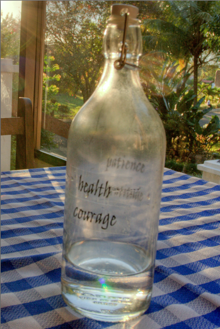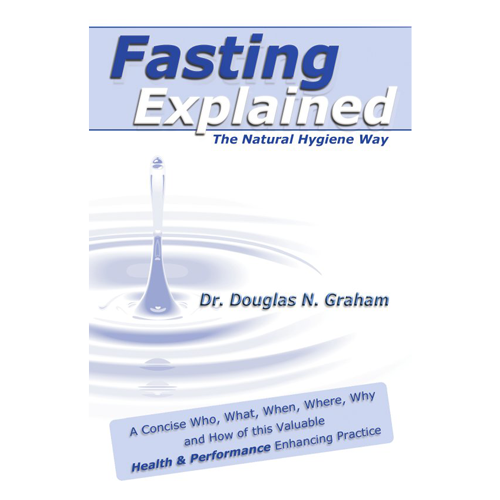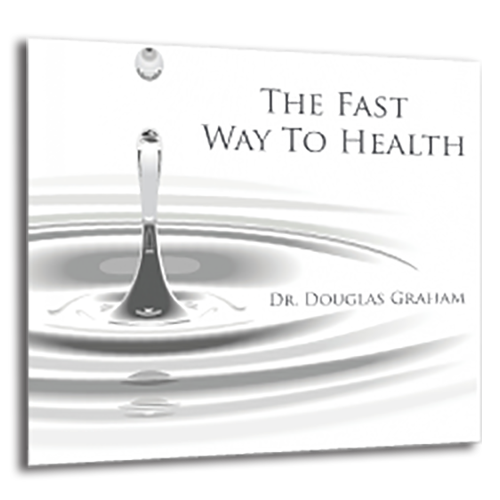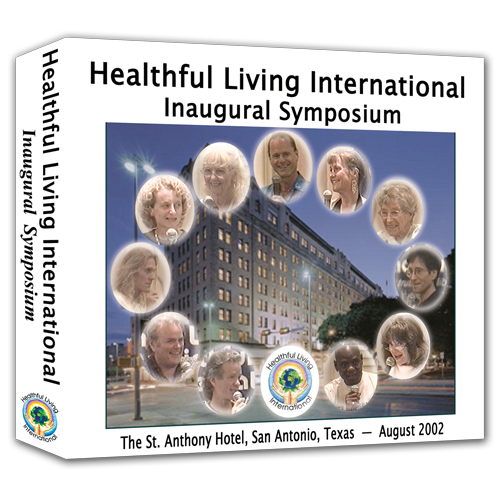Fast, Faster, and Fastest Results
by Dr. Graham
Published: Fri, 16 Jul 2010

The critical time to fast is when you don't have time for it.
—Dr. Douglas N. Graham
Fasting has been hailed as the ultimate rejuvenator. Done properly, it can take years off your appearance and add years to your life. Done improperly, fasting can be one of the worst, if not the last, experience of your life.
History of Fasting
Fasting dates back to before the beginning of recorded history and is mentioned in almost all early written records. It is highly likely that prehistoric humans and all early primates fasted regularly, as storing food was impossible, and food always becomes scarce once or twice a year. For early man, there was nothing to do but wait ... yet it was this very waiting that likely spurred the health, survival, and eventual success of mankind as a species.
Almost all of our greatest religious leaders and philosophers have mentioned their fasting experiences. Moses, Jesus, Hippocrates, Galen, Plato, Socrates, Paracelsus, Aristotle, Mahatma Gandhi, Paramahansa Yogananda, Mark Twain, and Benjamin Franklin were all known to have practiced fasting. In ancient Greece, in order to restore their health, men fasted for three days before entering an open-air temple where they would continue resting and eating fruit until they became fully recovered.
An animal that is "off his feed" cannot be induced to eat until his health is restored. Fasting is extremely common amongst almost all of the mammals, and it is often also noted in birds, fish, reptiles, and amphibians. Only in the last few decades, paralleling the meteoric rise in obesity amongst Western humans, has fear of fasting come into play.
Definitions of Fasting
Fasting is normal. This truth is reflected in our language. The word breakfast literally means "to end the fast," and it represents the beginning of an increased workload for the body.
The verb "to fast" runs deep in almost every human culture. Most people have used the term, and think they know what it means, until you ask them. Typically, people tell me that fasting means not eating. While not eating is certainly one part of a fast, and gives us a clue as to what fasting is not, it does not truly tell us what fasting is.
Many people refer to juice fasting (drinking only juice), and others use the phrase fruit fasting (consuming nothing but fruit). I have spoken with many people who have undergone dry fasting (no food, no water) and others who have taken water fasts (water only). Few people, however, have undergone truly hygienic fasting, which is the topic of this article.
Hygienic fasting is its own unique and separate concept. In Natural Hygiene, which is the science of human health, fasting is defined as the deepest and most comprehensive state of physical, emotional, sensory, and physiological rest that can be humanly achieved. It is during such a fast that healing, on all levels, takes place at the most rapid pace possible.
Four Types of Rest
Physical, emotional, sensory, and physiological rest are the four main types of rest that we need to consider when undergoing a hygienic fast. Rest is a relative term. When a person enters the deeper states of rest, we refer to it as fasting. Since most fasts are undertaken with some health goal in mind, making the fast as effective as possible is a major consideration. The deeper the rest, the more effective the fast.
Physical Rest
Physical rest is easy to understand but sometimes difficult to achieve. Essentially, the more time spent in a horizontal position, doing nothing, the better and deeper the physical rest. Exercise of any kind is contraindicated when fasting. Basic moving about should be minimized. Even speaking, reading, and listening to talk or music can be taxing. Energy should be conserved whenever possible in order to maximize the effectiveness of the fast.
Emotional Rest
Worry, doubt, fear, and other stressful emotions are counterproductive during a fast. Freedom from family issues and all other concerns makes fasting far more pleasant ... and maximizes the vital nerve energy available for healing. The fasting supervisor and all the staff earn their keep in helping to shield the faster from all forms of emotional distress, and by defusing any emotional "time bombs" that may arise during the fast.
Sensory Rest
City noises from sirens, horns, subways, trains, airplanes, machinery, automotive engines, loud voices, and loud music are all distracting energy zappers. Temperatures that are too hot or too cold, or unpleasant weather of any kind, makes for an uncomfortable fast. Comfort is truly the key when it comes to fasting. Any sensory input that is not pleasant drains energy. True sensory rest requires that we be in a natural setting where we can hear, smell, see, touch, and even taste that the environment is pristine.
Physiological Rest
We achieve physiological rest by minimizing the digestive demands placed upon our bodies. This is where abstaining from eating plays a role in fasting. The digestion of food can be extremely taxing on the system. Our digestive system requires a large percentage of our overall blood flow when processing food. A difficult-to-digest meal can actually cause a loss of consciousness, as we often see following holiday meals. This results when there simply isn't enough blood to satisfactorily supply the brain and the digestive system at the same, and so people go comatose. A similar phenomenon is being addressed when one is advised not swim immediately after eating a meal: the risk of muscle cramps rises dramatically after eating, as insufficient blood exists to supply the muscles and the digestive system simultaneously. During periods of extended physiological rest, energy is freed up that the body can utilize for healing and detoxification.
It is worth noting at this juncture that the human body will always detoxify itself in the manner that is easiest for itself while at the same time doing the least possible harm to itself. This means that, contrary to the common myth, the body will not ever harm itself by detoxifying "too fast" (though substantial discomfort, or even misery, may ensue as long-held toxins circulate in the blood on their way out).
Only by fully participating in all four areas of rest can we experience the amazing depth of healing and revitalization that the body is capable of generating.
Reasons for Fasting
Any time you don't actually feel like your normal self, a fast is indicated. This could mean something as simple as remaining in bed a few extra hours in the morning, or it could involve taking a few days off work for some deep rest. Fasting has been dubbed as "the ultimate cleanse." However, giving the body a chance to detoxify itself is only a small part of what fasting is about. In addition to general housecleaning, people choose to fast in order to reverse disease, improve athletic performance, and/or reach higher spiritual ground.
Whatever your motivation, on a properly supervised fast of sufficient length, you are likely to reach all of your goals, to varying degrees, and you will likely even exceed your expectations.
The Body's Agenda
I believe it is important to recognize that two agendas are actually at play when fasting: yours and your body's. You may have an agenda, let's say, of clearing up your acne, overcoming an old shoulder injury, and improving your digestion. Your body's agenda may include those issues, but it may also have other priorities, (of which you may have no awareness whatsoever), such as decongesting your liver, cleaning up heart valves, and improving circulation to your brain. During the fast, your body's agenda gets top priority, every time. And this is good news, for the body always organizes its agenda so as to secure the optimal functioning capacity for your body. While cosmetic concerns or painful conditions may sometimes come last, threats to existence get immediate attention.
How Long to Fast
Professionally, I divide supervised fasts into three categories: short, moderate, and long. A short fast is less than two weeks in duration. A long fast is longer than four weeks. A moderate fast is anything in between.
A properly run fast should be as short as possible but as long as necessary. I do not subscribe to setting a goal in terms of numbers of days of fasting. Instead, I suggest that fasters take their fast one day at a time. Fasting has no formula, in terms of length, for overcoming specific illnesses. Fasting is unpredictable, as too many variables affect each faster. Most important is the vitality of the individual, the setting in which the fast is undertaken, and the degree of damage that is hopefully to be overcome.
We can, however, generalize about the length of time that it will take to overcome specific ailments through fasting. Minor ailments, infections, and flu-like symptoms tend to respond quite quickly to fasting. Chronic conditions such as high blood pressure, long-term digestive disorders, and most arthritis and other autoimmune conditions, typically require a moderate fast in order to resolve. Fasts of a month or longer are typically reserved for very serious illness or tumor breakdown (autolysis), or they have been undertaken for purposes other than purely physical health.
Monitoring a Fast
Short fasts of one to three days' duration typically require little or no monitoring other than the "noticing" that each faster typically experiences. Determining what is a "short" fast and when has it become long enough so that the faster would be better served to have independent outside supervision is a matter of much conjecture, and should be discussed with an experienced professional before undertaking a fast.
Most fasts progress from start to finish quite uneventfully. However, I have seen people who required hospitalization after as little as just two days of fasting. I know of more than one individual who fasted unsupervised at home and lapsed into a coma from which he or she would have been unlikely to have recovered without medical intervention. I am a firm believer that proper supervision usually makes the difference between a safe, successful fast and an unsatisfactory, potentially lethal experience.
It is not my intention, in the short scope of this article, to teach others how to monitor a fast. I will say that when doing so, I typically evaluate approximately fifty distinct features of the faster's anatomy, physiology, mental state, and emotional outlook each day.

Breaking a Fast
Two major parts comprise the breaking of a fast: realimentation and regaining physical fitness. Fasting is relatively easy compared to breaking the fast. The number of decisions to be made when breaking the fast is far greater than those necessary when fasting. Fasting supervisors use many different strategies, and just as many rationales to explain them. I use a system of frequent small meals, and it works quite well, but I cannot begin to say that my system is better than someone else's. This method has worked beautifully for almost every faster I have supervised over the past 25 years, but I always remain open to learning new and better ways.
The length of the fast weighs heavily in determining the speed with which the fast is broken. Relatively short fasts require almost no special attention. Fasts of longer than a week merit respect, and should be broken gradually, over a period of several days. Fasts that are longer than two to three weeks require an even more extended break period. My general rule of thumb is that moderate to long fasts should not be broken in less than half the time of the fast itself. If a person can spend as many days gently refeeding and recovering as they did fasting, that is closer to the ideal. Full recovery from a fast is not likely to occur in fewer days than the length of the fast itself.
In both food and fitness considerations, the secret to successfully breaking a fast is to be gentle but progressive. Like an 18-wheeler advancing through its gears, one must gradually increase the body's digestive as well as fitness demands, while allowing plenty of time for recovery. Setbacks are to be avoided, as they can be devastating to the faster's morale. With proper guidance, it is common for fasters to notice they have surpassed their pre-fast fitness level after recovering for just half the length of the fast, or even less.
Who Should Not Fast
Fasting is contraindicated, at times, for a wide assortment of reasons. Neither pregnant mothers nor infants should fast longer than absolutely necessary. People on steroids and other prescription drugs must be very careful if they choose to fast, and they should do so only with guidance from a trained fasting professional. Insulin-dependent diabetics rarely fast successfully. Listing the many possible contraindications is almost pointless, as almost every rule has exceptions, and each faster must be handled on an individual basis. No two fasts are the same, not even for the same person. Check with a qualified fasting professional to see if you are a candidate for a fast, or whether fasting might not be a good idea for you.
Why Supervision Is Critical
If, after a fast, a person knows no more than he or she did before the fast, reverting to the lifestyle that necessitated the fast in the first place is almost inevitable. Though unfortunately quite common, such an experience can be worse than pointless; it can be pointlessly dangerous. While going through a fast, it is impossible to accurately assess your own physical condition, as blood-chemistry changes during a fast cloud decision-making ability. Without the benefit of the practiced eye of someone with sufficient medical background and specific training to recognize when you are entering dangerous ground, it is all too easy to go "over the edge."
There is more to good supervision, however, than simple safety. Education is vitally important for influencing behavior, and a well-supervised fast includes daily personal and group education about all aspects of healthful living. Just as top athletes use coaches, businessmen use consultants, and mountain climbers use guides, it is simply smart to take advantage of the experience and foresight provided by a good fasting supervisor. He or she can create an atmosphere of peace and calm, provide for all creature comforts, answer questions as they arise, and ensure that both the fast and the recovery period go smoothly.
Without benefit of a supervisor, roughly 90% of all fasts end prematurely, often during the first few days, simply because of runaway fear. Fear halts more fasts before their time than all other factors combined. Even with supervision, fear is ever-present. It takes a lot of training, as much experience, and excellent communication skills to be able to smooth the road for a successful fast and keep fear from adversely influencing the faster.
Surprisingly, after the fast ends, the value of the fasting supervisor increases even more dramatically. The supervisor must choose which foods are appropriate and how much and how often to serve those foods, and must truly cater to the faster, who at this time can be extremely needy and full of questions. Guidance with exercise, rest, and all aspects of lifestyle are critical at this time, and the rules change daily. Each day of recovering from a fast is different from the last, and custom guidance is essential to ensure that the recovery process does not take a turn for the worse.
How Often to Fast
The real trick in fasting is to learn to live life in such a way that frequent fasting is not required. I do not recommend undertaking long fasts frequently. Initially, once a year is enough for most people, unless they are attempting to undertake a linked series of fasts for specific health reasons. After a few years, when (hopefully) combined with truly healthful living in between the fasts, fasting can become almost totally unnecessary. Remember, even if you take a moderate to long fast once a year, the ratio of fasting days to nonfasting days still runs at least 10:1. Live cleanly in between your fasts, and you will minimize the need for fasting.

Idyllic Fasting
A tropical paradise, the absence of manmade sounds, comfortable temperatures, sunny and pleasant weather conditions, a clean environment, supportive people, educational guidance, the luxury of ample recovery time, and large doses of peace combine to give you the "being taken care of" feeling that makes for the idyllic fasting experience.
Articles:
- Sensory Fasting for Optimal Health by Dr. Graham
- Medical and Nonmedical Models of Health by Dr. Graham
- The 32 Elements of Health: How Round is Your Wheel? by Luke Sartor
- Which Banana Island Would You Like To Visit? by Dr. Graham
Self-Study Materials:

|
(DVD Video) 
|

|
